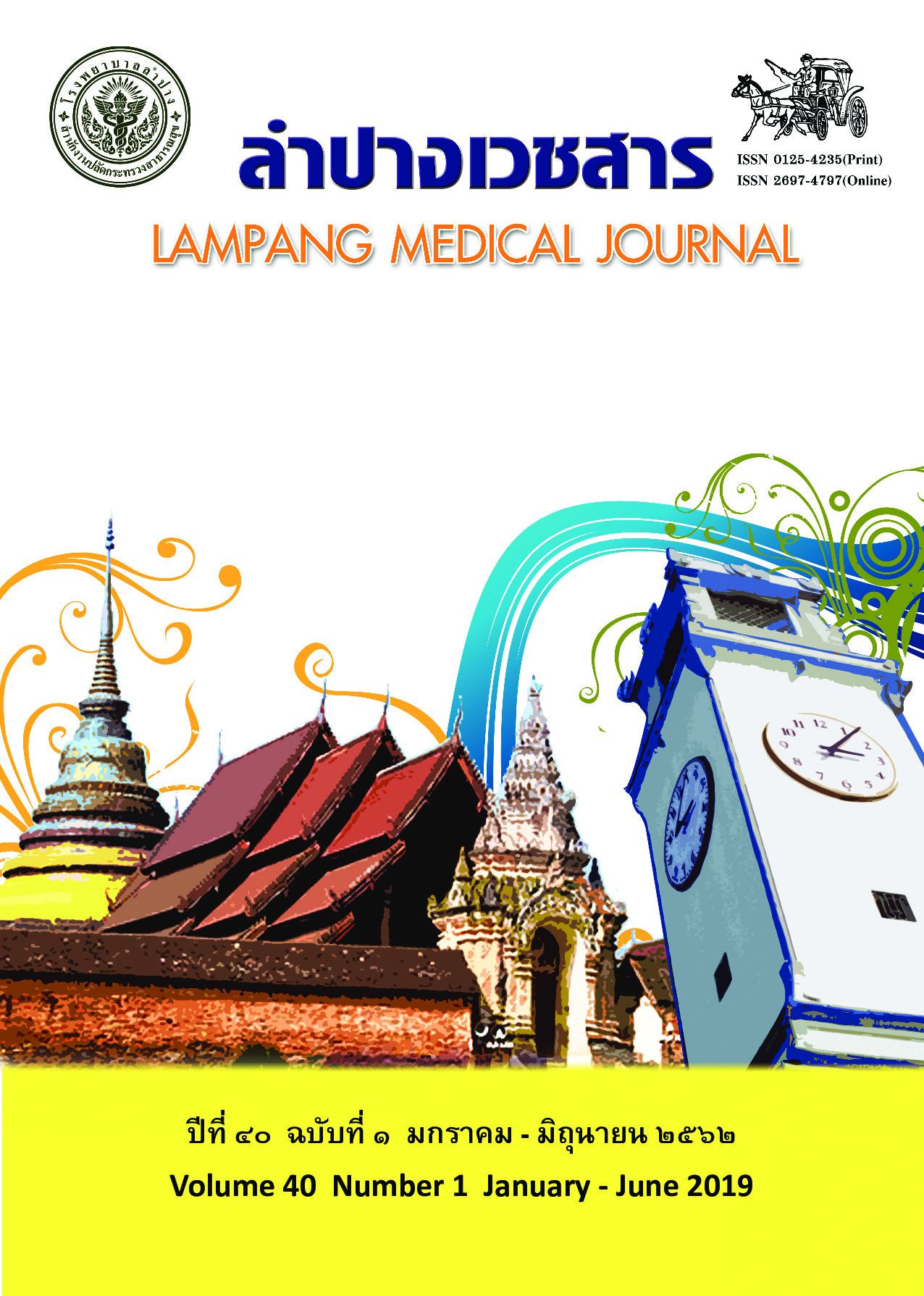Effects of the “My Self” Exercise Program for Improved Trunk Balance and Leg Strength in the Elderly
Main Article Content
Abstract
Background: The promotion of trunk balance and leg strength can help prevent falling of elderly people.
Objective: To determine the results from the implementation of the “My Self” exercise program regarding trunk balance and leg strength in the elderly.
Material and method: A quasi-experimental, pretest-posttest, two group design study was conducted among 80 women, aged 60-79 years old, who lived in That Phanom District, Nakhon Phanom Province, Thailand. Demographic data was not different between the two groups. The study group (n=40) practiced the “My Self” exercise program for 8 weeks (March-April 2018), whereas the control group (n=40) did their usual daily activities. The trunk balance was assessed by recording the duration for one-leg standing. The leg strength was assessed by recording the number of repetitions performed from a sitting to standing position, from a chair, within 30 seconds. The data was analyzed by using the Chi-square test and t-test.
Results: After the exercise program, the study group had significantly better trunk balance than the control group (16.3 ± 8.3 vs 10.5 ± 6.4 seconds, p=0.013), and achieved a higher degree of leg strength (12.3 ± 2.7 vs 8.2 ± 1.7 times, p<0.001).
Conclusion: The “My Self” exercise program could improve trunk balance and leg strength of the elderly.
Article Details
บทความที่ส่งมาลงพิมพ์ต้องไม่เคยพิมพ์หรือกำลังได้รับการพิจารณาตีพิมพ์ในวารสารอื่น เนื้อหาในบทความต้องเป็นผลงานของผู้นิพนธ์เอง ไม่ได้ลอกเลียนหรือตัดทอนจากบทความอื่น โดยไม่ได้รับอนุญาตหรือไม่ได้อ้างอิงอย่างเหมาะสม การแก้ไขหรือให้ข้อมูลเพิ่มเติมแก่กองบรรณาธิการ จะต้องเสร็จสิ้นเป็นที่เรียบร้อยก่อนจะได้รับพิจารณาตีพิมพ์ และบทความที่ตีพิมพ์แล้วเป็นสมบัติ ของลำปางเวชสาร
References
แห่งชาติ; 2556.
2. อารีรัตน์ สุพุทธิธาดา, รัมภา บุญสินสุข, ไพลวรรณ สัทธานนท์. คู่มือการดูแลผู้สูงวัย เดินดีไม่มีล้ม. นนทบุรี: โอเพ่นเวิลด์ส พับลิชชิง เฮาส์; 2559.
3. นริศรา อารีรักษ์, กุลวดี โรจน์ไพศาลกิจ, นวัสนันท์ วงศ์ประสิทธิ์. ผลของโปรแกรมการออกกำลังกายแบบผสมผสานต่อภาวะสุขภาพ สมรรถภาพทางกาย และความคาดหวังความสามารถตนเองของผู้สูง
อายุ. วารสารสาธารณสุข มหาวิทยาลัยบูรพา 2558;10(2):66-76.
4. Bandura A. Social foundations of thought and action. Englewood Cliffs, N.J: Prentice-Hall; 1986.
5. ศรินยา บูรณสรรพสิทธิ์, มยุรี ศุภวิบูลย์, สุภาภรณ์ ศิลาเลิศเดชกุล. ผลการฝึกกล้ามเนื้อแกนกลางลำตัวที่มีต่อความแข็งแรงและการทรงตัวในผู้สูงอายุ. วารสารคณะพลศึกษา 2555;15(2):119-31.
6. วีระยุทธ์ แก้วโมก. ผลการทำกายบริหารแบบมณีเวชต่อการทรงตัว ความยืดหยุ่นและความแข็งแรงของผู้สูงอาย. บูรพาเวชสาร 2560;4(1):31-9.
7. รัชนา หน่อคำ, ศิริรัตน์ ปานอุทัย, ทศพร คำผลศิริ. ผลของการออกกำลังกายแบบก้าวตามตารางต่อการทรงตัวในผู้สูงอายุ. พยาบาลสาร 2559;43(3):58-68.
8. ธีรวีร์ วีรวรรณ. ผลของการออกกำลังกายแบบผสมผสานต่อการทรงตัวในผู้สูงอายุเขตบึงกุ่ม กรุงเทพมหานคร. วารสารสาธารณสุขศาสตร์ 2555;42(2):44-53.
9. สายธิดา ลาภอนันตสิน, วาสนา เตโชวานิชย์, พันพิสสา ณ สงขลา, ยุพารัตน์ อดกลั้น, สุนันทา วีขำ. การพัฒนาสมรรถภาพการทรงตัวและความกลัวการล้มของผู้สูงอายุหญิงในตำบลองครักษ์และบางลูกเสือ จังหวัดนครนายกด้วยการบริการวิชาการชุมชน. วารสารกายภาพบำบัด 2558;37(2): 63-77.
10. Rikli RE, Jones CJ. Senior fitness test manual. Champaign, IL: Human Kinetics; 2001.


